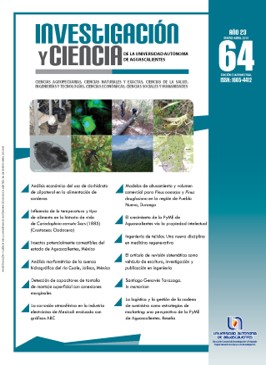Morphometric analysis of the Cuale river watershed, Jalisco, Mexico
DOI:
https://doi.org/10.33064/iycuaa2015643592Keywords:
watershed, morphometry, geographic information systemsAbstract
The morphometry of the Cuale River watershed was analyzed with topographical and hydrological information digitized at 1:50,000 from INEGI. Watershed delineation was verified correcting hydrological and topographical details and morphometric parameters that explain the dynamic effects of the hydrological behavior. The results were obtained with the programs of Geographic
Information Systems (GIS): Arc Gis 9.3 (ESRI, 2008) and Idrisi ® Taiga®. The landscape consists of a mountain system with inclines and slopes that accentuate the risk of runoff, a situation that has a decisive influence on their hydrological response and that should
be measured in spatial planning and integrated management.
Downloads
References
• Gaspari, F. J. Ordenamiento territorial en cuencas serranas. Aplicación de Sistemas de Información Geográfica (S.I.G.). Argentina: Ediciones Cooperativas. 147 pp., 2002.
• Gaspari, F. J. et al. Manual de manejo integral de cuencas hidrográficas. Argentina: Universidad Nacional de La Plata. 321 pp., 2009.
• González, M. A. Análisis morfométrico de la cuenca y de la red de drenaje del río Zadorra y sus afluentes aplicado a la peligrosidad de crecidas. Boletín de la A.G.E., 38: 311-329.
• HARLIN, J. M. Watershed morphometry and time to hydrograph peak. Journal of Hydrology, 67: 141-154, 1984.
• HENAOS, J. E. Introducción al manejo de cuencas hidrográficas. Bogotá, Colombia: Universidad Santo Tomás. Centro de Enseñanza Desescolarizada. 399 pp., 1988.
• Hernández, M. Z. Mapa de susceptibilidad a procesos de remoción en masa con base en análisis multivariado: la región de Zapotitlán de Méndez, Puebla. Tesis de Maestría. Universidad Nacional Autónoma de México, Centro de Geociencias. 110 pp., 2008.
• HORTON, R. E. Erosional development of streams and their drainage basins: Hidrophysical approach to quantitative morphology. Geol, Soc. America Bull., 56: 275-280, 1945.
• INEGI (INSTITUTO NACIONAL DE ESTADÍSTICA, GEOGRAFÍA E INFORMÁTICA). Carta Edafológica. F13C69 y F13C79. México: Autor, 1974.
• INEGI (INSTITUTO NACIONAL DE ESTADÍSTICA, GEOGRAFÍA E INFORMÁTICA). Geología. Cartas: F13C69 y F13C79. México. [cd-rom]. 2010.
• LANGBEIN, W. B. Topographic characteristics of drainage basins. U.S. Geology Survey. Water-Supply Paper. 968-C: 125-155, 1947.
• Llamas, J. Hidrología General, Principios y Aplicaciones. Bilbao, España: Servicio Editorial de la Universidad del País Vasco. 635 pp., 1993.
• López Cadenas de Llano, F. Restauración hidrológica forestal de cuencas y control de la erosión. Ingeniería medioambiental. España: Mundi Prensa-TRAGSATEC-Min. Medio Ambiente. 945 pp., 1998.
• LUO, W. Quantifying groundwater-sapping landforms with a hypsometric technique. Journal of Geophysical Research, 105: 1685-1694, 2000.
• LUO, W. y HARLIN, J. M. A theoretical travel time based on watershed hypsometry. Journal of the American Water Resources Association, 39: 785-792, 2003.
• MATTER, M. A. et al. Characterizing hidroclimatic variability in tributaries of the Upper Colorado River Basin. Journal of Hidrology, 380(3): 260-276, 2009.
• MÉNDEZ, W. y MARCUCCI, E. Análisis morfométrico de la microcuenca de la quebrada Curucutí, estado Vargas - Venezuela. Revista Geográfica Venezolana, 47(1): 29-55, 2006.
• Mintegui Aguirre, J. A. et al. Avenidas torrenciales en el arroyo del Partido y su incidencia en la Marisma del Parque Nacional de Doñana. Naturaleza y Parques Nacionales [Serie Técnica]. Madrid, España: Editorial Organismo Autónomo Parques Nacionales. Ministerio de Agricultura, Alimentación y Medio Ambiente. 373 pp., 2003.
• MOGLEN, G. E. y BRAS, R. L. The effect of spatial heterogeneities on geomorphic expression in a model of basin evolution. Water Resources Research, 31: 2613-2623, 1995.
• Moreno, A. et al. Sistemas y Análisis de la Información Geográfica. Manual de autoaprendizaje con ArcGIS. México: Alfaomega Grupo Editor, S. A. 940 pp., 2008.
• SALAS AGUILAR, V. M. et al. Morfometría de la cuenca del río Nazas-Rodeo aplicando tecnología geoespacial en Durango, México. TECNOCIENCIA Chihuahua, 5(1): 34-42, 2011.
• SOLÍS, M. R. et al. Análisis de la cubierta vegetal de la cuenca alta del río Nazas en Durango, México. Revista Chapingo: Serie de Ciencias Forestales y de Ambiente, 12(04): 139-143, 2006.
• STRAHLER, A. N. Quantitative Analysis of Watershed Morphology. Transactions of the American Geophysical Union, 38(6): 913-920, 1957.
• Tucker, G. et al. Statiscal analysis of drainage density from digital terrain data. Geomorphology, 36: 187-202, 2001.
• VIRAMONTES, O. O. et al. Morfometría de la cuenca del río San Pedro Conchos, Chihuahua. TECNOCIENCIA Chihuahua, 1(3): 21-31, 2007.
• VIVONE, E. R. et al. Hypsometric control on surface and subsurface runoff. Water Resources Research, 44: W12502, 2008.
• WILLGOOSE, G. y HANCOCK, G. Revisiting the hypsometric curve as an indicator of form and process in transport-limited catchment. Earth Surfaces Processes Landforms, 23: 611-623, 1998.
De páginas electrónicas
• Quintero, T. P.R.P.C. Río Cuale, Microcuenca El Cuale, Municipio de Talpa de Allende. SAGARPA-FIRCO (Documento no publicado), 2004. Recuperado el 4 de noviembre de 2012, de http://www.firco.gob.mx/Paginas/default.aspx
Downloads
Published
How to Cite
License
Copyright (c) 2015 Bartolo Cruz Romero, Fernanda Julia Gaspari, Alfonso Martín Rodríguez Vagaría, Fátima Maciel Carrillo González, Jorge Téllez López

This work is licensed under a Creative Commons Attribution-NonCommercial-ShareAlike 4.0 International License.
Las obras publicadas en versión electrónica de la revista están bajo la licencia Creative Commons Atribución-NoComercial-CompartirIgual 4.0 Internacional (CC BY-NC-SA 4.0)









